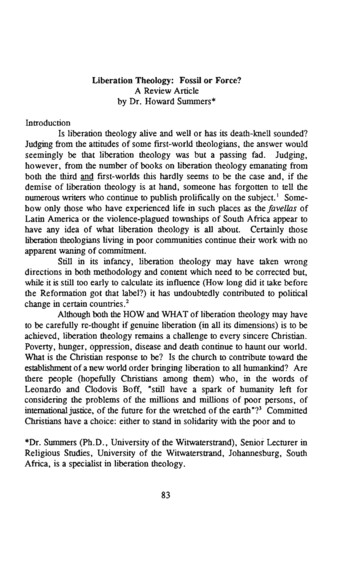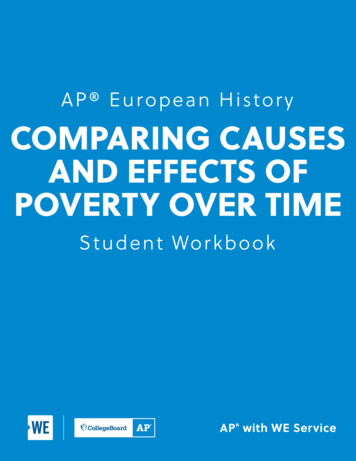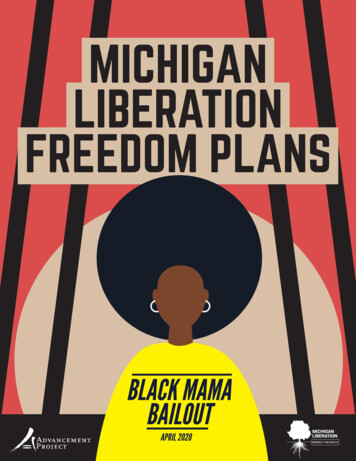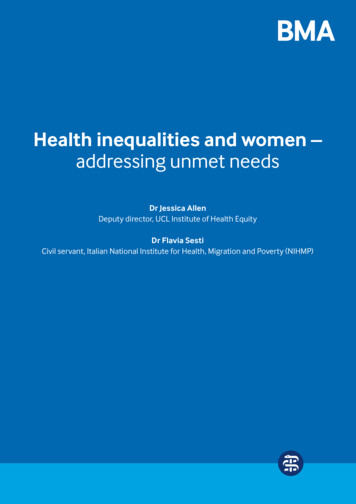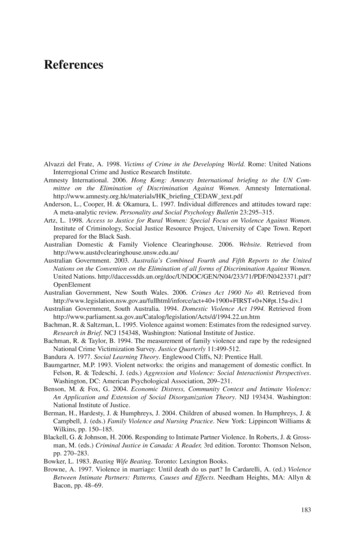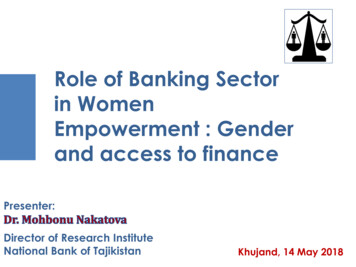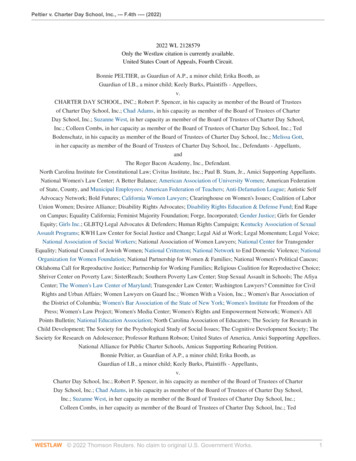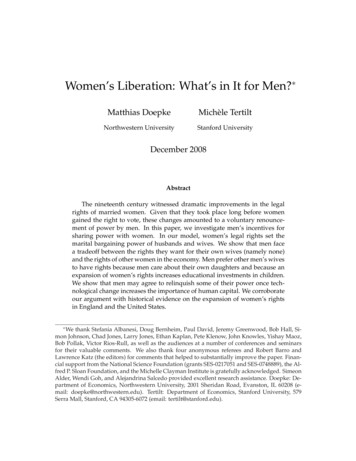
Transcription
Women’s Liberation: What’s in It for Men? Matthias DoepkeMichèle TertiltNorthwestern UniversityStanford UniversityDecember 2008AbstractThe nineteenth century witnessed dramatic improvements in the legalrights of married women. Given that they took place long before womengained the right to vote, these changes amounted to a voluntary renouncement of power by men. In this paper, we investigate men’s incentives forsharing power with women. In our model, women’s legal rights set themarital bargaining power of husbands and wives. We show that men facea tradeoff between the rights they want for their own wives (namely none)and the rights of other women in the economy. Men prefer other men’s wivesto have rights because men care about their own daughters and because anexpansion of women’s rights increases educational investments in children.We show that men may agree to relinquish some of their power once technological change increases the importance of human capital. We corroborateour argument with historical evidence on the expansion of women’s rightsin England and the United States. We thank Stefania Albanesi, Doug Bernheim, Paul David, Jeremy Greenwood, Bob Hall, Simon Johnson, Chad Jones, Larry Jones, Ethan Kaplan, Pete Klenow, John Knowles, Yishay Maoz,Bob Pollak, Victor Rios-Rull, as well as the audiences at a number of conferences and seminarsfor their valuable comments. We also thank four anonymous referees and Robert Barro andLawrence Katz (the editors) for comments that helped to substantially improve the paper. Financial support from the National Science Foundation (grants SES-0217051 and SES-0748889), the Alfred P. Sloan Foundation, and the Michelle Clayman Institute is gratefully acknowledged. SimeonAlder, Wendi Goh, and Alejandrina Salcedo provided excellent research assistance. Doepke: Department of Economics, Northwestern University, 2001 Sheridan Road, Evanston, IL 60208 (email: doepke@northwestern.edu). Tertilt: Department of Economics, Stanford University, 579Serra Mall, Stanford, CA 94305-6072 (email: tertilt@stanford.edu).
1 Introduction“Once married, a bride was obliged by law and custom to obey her husband—a requirement so fundamental to the biblical idea of a wife that it remained in most Jewish andChristian wedding vows until the late twentieth century. After all, wives were considered a husband’s ‘property,’ alongside his cattle and his slaves.”(Yalom 2001)The cause of gender equality has made dramatic progress over the past 200 years.Today, the expansion of political rights through female suffrage, introduced in1918 in the United Kingdom and in 1920 in the United States, is often regarded asthe main breakthrough. However, important reforms of women’s economic rightstook place much earlier. In England and the United States (which have similarcommon-law legal systems), this is especially true for the rights of married women. Prior to 1830, in these countries married women essentially had no rightsat all, as all legal authority rested with their husbands. This meant that a marriedwoman could not own property, she could not enter into contracts, she had norights to her own earnings, she had no parental rights over her legitimate children, and she could not obtain a divorce. Throughout the nineteenth century,both England and the United States carried out a series of reforms in areas suchas child custody, divorce, and marital property law that substantially altered therights and obligations of husbands and wives during and after marriage. By theend of the century, the rights of husbands and wives in these areas were close tobeing equal.Our research is motivated by the observation that this great improvement of married women’s economic rights took place before women were granted politicalrights. All the reform laws of this period were passed by all-male legislatures thatwere accountable only to male voters. Given that the granting of rights to womenimplied a weakening of men’s rights, it amounted to a voluntary renouncementof power by men. This brings us to our main question: Why would men everagree to grant more economic rights to women?The idea put forth in this paper is that from a man’s perspective, there is a tradeoff between the rights of his own wife versus the rights of other men’s wives.Improvements in married women’s economic rights increase women’s bargain1
ing power relative to their husbands within the household. Since husbands havenothing to gain from an increase in their wives’ bargaining power at their own expense, men ideally want their own wives to have no rights. But men might standto gain from other women having rights. We focus on two channels that give mena stake in the rights of other men’s wives. First, men are altruistic towards theirown children, half of which are daughters. Men prefer their daughters to have astrong bargaining position vis-à-vis their sons-in-law.1 Second, in our model animproved bargaining position for wives translates, among other things, into increased investments in children’s human capital. A father prefers his children tofind high-quality mates, and therefore stands to gain from increasing the powerof his children’s future mothers-in-law.We argue that this tradeoff between the rights of a man’s own wife versus thoseof other men’s wives has shifted over time, because of a changing role of humancapital. When the return to education increases, finding well-educated spousesfor one’s children becomes a more important concern. Similarly, a rising returnto education increases fathers’ concern about the rights of their daughters, because the daughter’s marital bargaining power matters for the grandchildren’seducation. According to our theory, the ultimate cause of the expansion of women’s rights throughout the nineteenth century was technological change thatincreased the demand for human capital. This change elevated the importanceof children’s education, it strengthened men’s incentives to expand women’s bargaining power, and it ultimately induced men to voluntarily extend rights to women.The framework for our theoretical analysis is an overlapping-generations modelin which married couples face a tradeoff between the quantity (i.e., number) andquality (i.e., education) of their children. In addition, couples have to allocateconsumption between husband and wife. Our theory builds on the altruisticparents model of Becker and Barro (1988) and Barro and Becker (1989). Wemodify the original setup by explicitly modeling husbands and wives.2 We fol1Washington (2008) and Oswald and Powdthavee (2009) provide empirical evidence thatmen’s political preferences are influenced by their number of daughters.2Papers that analyze two-gender OLG models in non-altruistic settings include Aiyagari,Greenwood, and Guner (2000), Fernández, Guner, and Knowles (2005) and Tertilt (2005).2
low Chiappori (1988, 1992) and model household decision-making by solving aPareto problem, with different weights on husband and wife that represent theirrelative bargaining power. There is disagreement between the spouses in two dimensions. First, even though the spouses are altruistic towards each other, bothhusband and wife value their own consumption more than their spouse’s. Marital bargaining power therefore affects the allocation of consumption. Second,we assume that mothers care more about the well-being of their children thanfathers do. Bargaining power therefore also matters for the children’s education;in particular, extending rights to women will lead to more education.3We then analyze the economic implications of two alternative political regimes.Under patriarchy all family decisions are made solely by the husband, whereasunder empowerment decisions are made jointly by husband and wife. We allowmen to vote on the political regime, and we analyze their incentives for supporting empowerment. We find that when returns to education are low, men arebetter off living in patriarchy. As returns to education increase, parents chooseto have fewer children and to educate them more. We show that once returns toeducation reach a critical threshold, men stand to gain from improving women’srights and will vote for empowerment.As an extension, we consider an environment where human capital formationdepends not only on parental inputs, but also on government-provided publiceducation. Male voters choose the quality of public education in addition to voting on female empowerment. We find that an increase in the returns to humancapital leads to a higher quality of public education. Moreover, as long as pubFernández, Fogli, and Olivetti (2004) also provide a formal model where men’s attitudes towards women change endogenously, although the application is to female labor force participation rather than women’s rights.3The idea that female empowerment leads to higher investments in child quality is alsopresent in Edlund and Lagerlöf (2004), who have a model in which a shift in power towardswomen leads to faster human capital accumulation (see also Iyigun and Walsh 2007b). Eswaran(2002) argues that one reason for such behavior is that women bear relatively higher utility costsof child-bearing (e.g. pains and mortality associated with child-bearing) than men. In anotherempirical contribution, Miller (2008) analyzes the connection between women’s suffrage, publichealth spending, and child survival rates in the U.S. and argues that investment in children increased significantly in response to women having more power. Similar ideas are also extensivelydiscussed in the demography literature (Federici, Mason, and Sogner 1993). In Gould, Moav, andSimhon (2008), the link from female education to investments in children leads to a switch frompolygyny to monogamy once the return to education is sufficiently high.3
lic and private inputs in human-capital formation are complements, support forpublic education and female empowerment is mutually reinforcing. In anotherextension, we examine the alternative hypothesis that an increase in the demandfor female labor may have led to female empowerment. We find that, in thecontext of our model, such a demand shift leads to higher female education andlabor supply, but does not alter men’s incentives to vote for empowerment. Thus,both extensions are consistent with our view that an increase in the demand forhuman capital was the main driver of the expansion of women’s rights in thenineteenth century.We corroborate our arguments with historical evidence on the expansion of women’s economic rights in England and the United States. Our theory places theintroduction of women’s rights in the context of the demographic transition andthe increased accumulation of human capital in the second phase of the industrial revolution.4 We show that the historical timing of increased investments ineducation, declining fertility, and the expansion of women’s rights is consistentwith the implications of our theory. We also show that the historical debates surrounding the major reforms of women’s rights during this period reflect the keyarguments in our analysis. Based on evidence from parliamentary debates andnewspaper editorials, we document that in both England and the United Statesthere was a gradual shift during the nineteenth century from arguments that concentrate on the rights of men towards a view that gives first priority to the needsof children.Our mechanism is is also consistent with existing empirical evidence that exploitsthe state-by-state variation in the expansion of women’s rights in the UnitedStates. Geddes and Lueck (2002) find that the first states to extend property andearnings rights to women were those that had a higher city population, more female schooling, and higher average household wealth. Given that human-capitalintensive sectors are generally associated with urban rather than rural production, these findings are consistent with our theory. Roberts (2006) examines an4To this end, our theory builds on unified models of economic and demographic change suchas Galor and Weil (1996), Galor and Weil (2000), Greenwood and Seshadri (2002), Hansen andPrescott (2002), Boldrin and Jones (2002), Doepke (2004), and Jones and Schoonbroodt (2007).However, none of these papers focus on political changes.4
alternative hypothesis, namely that women’s rights were expanded because ofan increase in women’s participation in the formal labor market. However, hefinds that female labor-force participation was in fact higher in states without women’s earnings and property laws. Moreover, using a difference-in-differencesapproach, Roberts does not find any causal effect of a change in women’s rightson female labor-force participation. Fernández (2008) also builds on the empirical analysis in Geddes and Lueck to investigate the role of fertility. As our theorywould predict, she finds a negative correlation between fertility and women’srights at the state level. When including fertility in a regression similar to thespecification in Geddes and Lueck, Fernández finds that household wealth is nolonger statistically significant. These findings suggest that changes within the organization of families, rather than women entering the labor force, played a keyrole in the extension of economic rights to women.Our theory leads to an interesting reassessment of the relationship between traditional family roles and the progress of women’s liberation. During the twentiethcentury, a major focus of the women’s liberation movement was the advancement of women in the formal labor market. From this perspective, traditionalrole models and the glorification of motherhood were often viewed as obstacleswhich the women’s liberation movement aimed to overcome. A longer-term perspective, however, reveals that the “traditional” roles for women and mothersare a relatively recent invention. Social historians document that the sharp distinction between the roles of mothers and fathers in the household as well asthe heightened status of motherhood arose only in the nineteenth century, whenindustrialization led to a greater separation of home and work spheres and thenurturing and education of children gained in importance. In our theory, it is exactly the increasingly prominent role of mothers in the education of their childrenthat triggers improvements in women’s rights.By focusing on the “supply” of rights by men, our approach provides a contrastto theories advanced by historians that focus on the “demand” side by highlighting the role of the women’s movement in achieving gender equality. In the economics literature, there are only a few papers that attempt to explain changes inthe legal position of women. Geddes and Lueck (2002) emphasize that women’s5
rights will expand when an increasing return to female labor induces more women to enter the formal labor market. While such arguments may be applicableto more recent changes in women’s rights, they are unlikely to be relevant for themajor reforms of married women’s rights during the nineteenth century, becausethese occurred long before married women entered the formal labor market inlarge numbers. As late as 1920 (when female suffrage was introduced at the federal level), only five percent of married women in the United States were in thelabor force. Another strand of the literature focuses specifically on the extension of political rights to women, which we do not consider here.5 For example,Bertocchi (2007) argues that a decline of the gender wage gap reduced disagreement about the optimal tax rate between men and women, which lowered thecost for men to include women in the franchise. While interesting, this argumentis not applicable to the nineteenth-century reforms of the economic rights of married women, which took place long before women received the right to vote.6In the next section, we provide a summary of the main reforms of married women’s economic rights throughout the nineteenth century in England and theUnited States. Section 3 sets up the model. In Section 4 we analyze men’s incentives to share power with women and describe the transition from patriarchyto empowerment that is triggered by a rise in the return to education. In Section 5 we consider several extensions. Section 6 contains historical evidence fromEngland and the United States. Section 7 concludes and discusses some implications of our theory for economic development. All proofs are contained in themathematical appendix.5Empirical papers on the causes and consequences of female suffrage include Jones (1991),Lott and Kenny (1999), Edlund and Pande (2002), and Funk and Gathmann (2006).6Papers that analyze the general extension of the franchise (not restricted to women) includeAcemoglu and Robinson (2000, 2006), Lizzeri and Persico (2004), Diaz (2000), and Jack and Lagunoff (2006). The arguments in these papers are specific to expansions of political rights. Ourwork is more closely related to Galor and Moav (2006), who argue that an increase in the return toeducation helped overcome the historical conflict between workers and capitalists and inducedcapitalists to support public education.6
2 The Expansion of Married Women’s Rights in theNineteenth CenturyUp until the nineteenth century, the English common law (which formed thefoundation of the legal systems in both England and the United States) distinguished sharply between the rights of a feme sole, a single woman, and a femecovert, a married woman. Single women’s economic rights were nearly on parwith those of men: these women could own property, hold land, make a willor contract, and they had full parental rights over their (illegitimate) children(Hecker 1971).7 Upon marriage, however, a woman became a feme covert andlost these rights: the legal rights of husband and wife were merged and subsequently exercised solely by the husband. As a consequence, married women hadno separate legal existence.8Throughout the nineteenth century, the disparity in the rights of husbands andwives was reduced substantially through a series of reforms in areas such aschild custody law, divorce law, and marital property law. Most of these civillaw changes ultimately concerned the distribution of power within a household.In contrast, the main reforms to women’s political rights (such as the right to voteand the right to sit on juries) occurred only in the twentieth century.One of the earliest legal changes was in child custody rules, with Iowa beingthe first U.S. state that permitted custody to mothers in 1838.9 In England, theCustody of Infants Act was passed in 1839 and allowed mothers to be awardedcustody of children under the age of seven in the event of separation or divorce.These laws were expanded on a number of occasions, and by the end of the cen7However, in contrast to economic rights, political participation was equally limited for married and single women.8The legal impotence of married women in the mid-nineteenth century is famously summarized in Elizabeth Cady Stanton’s Seneca Falls Declaration and Caroline Norton’s pamphlet “ALetter to the Queen on Lord Chancellor Cranworth’s Marriage and Divorce Bill” (Stanton 1848and Norton 1855) for the United States and England, respectively. Stone (1977) gives a detaileddescription of the legal position of wives in sixteenth and seventeenth century England.9Note that the majority of laws concerning the legal status of women in the U.S. were statelaws, which meant that legal rights varied somewhat from state to state and that changes occurred at different points in time. However, all states eventually went through the same transition(Mason 1994).7
tury mothers could be awarded custody of all minor children, regardless of age.In divorce law, a key step was the passing of the 1857 Matrimonial Causes Act,which permitted secular divorce in England and allowed both men and womento apply for divorce. The act also gave divorced women the status of feme sole,and thus the same legal rights as single women. Similarly, in the United Statesdivorce laws were relaxed gradually over the century. By 1900, almost all statesallowed divorce on grounds of cruelty (Griswold 1986).Another major area of reform was marital property law. Here, the United Statestook the lead. The first state to pass a law allowing married women to ownseparate property was Maine in 1844, closely followed by New York in 1848.10 InEngland, the Married Women’s Property Act was passed in 1870 and expandedin 1874 and 1882. The reforms to property law dramatically improved the legalposition of married women relative to their husbands by giving them controlover their earnings and property and the ability to write contracts (Holcombe1983).Political rights, including most importantly female suffrage, were reformed onlyseveral decades after married women’s economic rights had been expanded. The19th Amendment to the United States Constitution granted full voting rights towomen in 1920.11 Similarly, most English women gained full voting rights in1918 through the Representation of the People Act. Other forms of political engagement, such as jury service, continued to be denied to American women longafter they gained the right to vote.12One exception to the relative timing in reforms of economic and political rightswas school suffrage, i.e., the enfranchisement of women to vote and run in localschool district elections. In Kentucky, school suffrage was granted to women10Many more states introduced similar laws in the 1860s and 1870s, and by the end of thenineteenth century all married women in the United States had access to some form of propertyand/or earnings protection. See Khan (1996) for a detailed account of these laws in the UnitedStates.11Some states had granted suffrage to women for state election prior to the 19th Amendment,but only four states prior to 1900 (Wyoming 1869, Utah 1870, Colorado 1893, and Idaho 1896),with the majority of states following after the 19th Amendment.12For example, as as late as 1961 the Supreme Court upheld Florida’s practice of automaticallyexempting women from jury service (Ritter 2006).8
already in 1838 (Hecker 1971). Similarly, in England the Elementary EducationAct of 1870 established the same active and passive election rights for men andwomen (Hecker 1971). School suffrage is an interesting case because, while apolitical right, it is tied directly to the education of children. In most states, schoolboards had some control over setting property taxes to finance schools. Thus,giving women the right to vote for school boards was a way to allow femalepreferences regarding children’s well-being to enter the decision-making process.We discuss school suffrage from the perspective of our theory in Section 5.In the labor market, unequal legal treatment of men and women persisted longinto the twentieth century. In the United States, restrictions on hours worked,wages, and work conditions of female employees were introduced by almost allstates during the late nineteenth and early twentieth centuries and stayed in placeuntil the 1960s (Goldin 1990, chapter 7). Marriage bars, which excluded marriedwomen from certain occupations such as clerical work and teachers, were common until the second world war. Comprehensive legislation that guaranteedequal treatment in the labor market was introduced mostly in the second half ofthe twentieth century.13While our focus is on England and the United States, legal reforms in other majorindustrializing countries during the nineteenth century followed a broadly similar pattern. In France and Germany, countries with legal origins distinct fromthe English model, married women’s rights initially were stronger than in theAnglo-Saxon countries. For example, the Prussian Civil Code of 1794 explicitlystated the principle of gender equality. Similarly, the French Revolution generated some early advances for women’s rights. The Constitution of 1791 established marriage as a civil contract that included some basic rights for marriedwomen. However, this was reversed in the French Civil Code of 1804, whichstated that wives owed obedience to their husbands and that the husbands hadcontrol of communal property (Stetson 1987).1413An important example is Title VII of the 1964 Civil Rights Act, which prohibited employmentdiscrimination based on race, color, religion, sex and national origin (see Goldin 1990, chapter 6).14Our analysis has little to say about why the position of married women was different initiallyin France and Germany relative to the United States and England. Obviously a variety factorscome into play when specific laws are implemented, not all of which are represented in ourtheory.9
Despite the difference in initial conditions, as in England and the United Statesthe rights of married French and German women improved substantially in thelate nineteenth and early twentieth centuries. The German Civil Code of 1900was a big step forward for married women in Germany, as it established a married woman’s right to her own earnings, recognized gender equality regardinglegal relationships, and eliminated the representative agency of the husband (Vogel 1993). In France, in 1881 married women were allowed to open savings accounts. Divorce became legal in 1884, and women received the rights to theirown earnings in 1907 (Stetson 1987). As in England and the United States, women gained the right to vote only long after these economic rights were granted(1918 in Germany and 1938 in France).3 A Model of Women’s RightsOur model economy is populated by overlapping generations of men and women who are joined in marriage. Each household is composed of a husband, awife, and their children. Couples have to decide on fertility, the education of theirchildren, and the allocation of consumption between the husband and the wife.Women’s rights are represented as the relative bargaining power of the husbandand the wife in the decision making of the household.15 Women’s rights are endogenous; in particular, men can vote on whether to extend rights to women.The aim of our analysis is to determine how the economic environment affectsmen’s incentives to grant rights to women.3.1 Preferences and ConstraintsEach couple in our economy has an equal number of sons and daughters. We usei {m, f } to denote gender (male or female) and i to denote the gender opposite to i. People care about their own consumption ci , their spouse’s consumption15Echevarria and Merlo (1999) use a related two-parent dynastic model to analyze gender differences in education. There is no voting on women’s rights, but men can improve the positionof their daughters by choosing a higher education level, which increases the daughters’ outsideoptions and hence their bargaining positions in marriage.10
c i , their number of children of each gender n (i.e., n sons and n daughters), and0the average of the utilities of their sons Umand daughters Uf0 . The utility functionof an adult i with spouse i is given by:µ0Ui (ci , c i , n, Um, Uf0 ) u(ci , c i , n) γi0Um Uf02¶,(1)where:u(ci , c i , n) log(ci ) σ log(c i ) δ log(n).Thus, σ is the weight on spousal consumption, and δ is the weight on the numberof children. We assume that 0 σ 1 (people value their spouses’ consumptionless than their own) and δ 0 (people like children). The only gender-specificpart of the utility function is the weight γi 0 attached to the welfare of thechildren.A central assumption of our model is that women attach relatively more weightto the welfare of their children than men do, i.e., γf γm . There is a substantial empirical literature supporting this assumption. Several studies use natural experiments to show that when women have control of household decisions,they tend to spend more resources on children.16 From an evolutionary perspective, the altruism gap between women and men can be rationalized by higherpaternity uncertainty for men or by the more limited reproductive capacity ofwomen.17 Note that the utility weight attached to children differs between mothers and fathers only with regard to the children’s well-being, not their number.In other words, we assume that men and women have different views of thequantity-quality tradeoff, which is critical for the results.1816See Lundberg, Pollak, and Wales (1997), Pitt and Khandker (1998), Case and Deaton (1998),and Attanasio and Lechene (2002).17See Wright (1995) for a summary of the key arguments in the evolutionary psychology literature. For an empirical documentation of paternity uncertainty see Anderson (2006). Anotherreason for the asymmetry might be that altruism towards children increases in time spent withchildren, and that women typically do most of the child-rearing. Bauer and Chytilova (2008)presents experimental evidence from India showing that women are more patient than men onaverage and that women’s patience increases with their number of children.18There is evidence that men in fact desire a larger number of children than women (seeBankole and Singh 1998 and Mason and Taj 1987). Shiue (2008) presents data from Chinese clansshowing that the quantity-quality tradeoff was already relevant for family decision-making before the industrialization period.11
Both spouses have one unit of time available. Men use all of their time for work,tm 1, while women split their time between working, tf , and raising and educating children. The assumption that women bear the entire burden of caringfor children is not crucial, but is made for simplicity and realism.19 Weakening oreven reversing this assumption would not alter the main results.The labor effort of men and women is combined by a Cobb-Douglas householdproduction function to produce the consumption good. For a family where thehusband and the wife have human capital Hm and Hf , respectively, the budgetconstraint for consumption is given by:cm cf A(tf Hf )α (tm Hm )1 α ,(2)where 0 α 1.There is a time cost φ
Northwestern University Michele Tertilt Stanford University December 2008 Abstract The nineteenth century witnessed dramatic improvements in the legal rights of married women. Given that they took place long before women gained the right to vote, these changes amounted to a voluntary renounce-ment of power by men.
